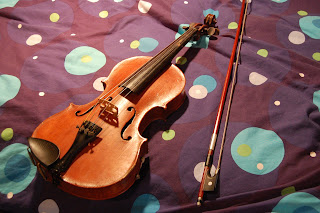I've never liked like the idea of using reference tracks. I listen to a fair amount of music and figure that I know what it sounds like, and know when it sounds good, and I don't need to check my answers in the back of the book. But I'm forcing myself to do it with this album, so I grabbed a few CDs that I had lying around and imported them.
Looking at them in waveform made me feel a whole lot better. These CDs have been mastered completely differently, but that doesn't stop people from loving them the same. So there are no right answers, although Bob Katz argues there should at least be standards and I think his argument is a good one.
I used the Izotope Ozone 5 Mastering plugin to measure a few parameters that I could compare across my sample CDs. I compared the loudest moments (M), the average loudness (I), the loudness range (LU), and the meter peaks for the left and right channels. The unit is LUFS, for what it's worth.
The loudest tracks are the newest. The Old Canes' "Flower Faces", from 2009's Feral Harmonic, is going for lo-fi and plans to misuse your stereo equipment to achieve a very dirty sound, which is great and suits the music just fine. The contemporary Arcade Fire, Coldplay, and Said the Whale tracks I picked were also very loud, but fairly clean. The Deer Tick album is an exception. It's more in line with the 90's albums (Built to Spill, Fiona Apple, REM) in terms of loudness, as is the Jam's "That's Entertainment" which was digitally remastered in 1997. The Beatles' "Here Comes the Sun", remastered ten years earlier, is by far the quietest.
The loudness range isn't very comparable since it's dependent on song structure and dynamics, but they can be guessed pretty easily by looking at the waveforms. The Arcade Fire, Old Canes, and Said the Whale songs almost have a binary dynamic range; they come on and there is music (loud) or there is not music (off). The Built to Spill song I happened to choose has the clearest dynamics, but the rest of the album behaves much like contemporary late 2000 releases, at least on my tiny sample size.
The highest peaks show us that only the Old Canes and the Said the Whale tracks exceed 0 by any appreciable margin, while the Arcade Fire and Fiona Apple tracks achieve a L/R sum of zero at their loudest moments. The Beatles remaster leaves a lot more room than any other track.
All in all, I think even with my small sample I've learned that CD mastering is different than it was ten or twenty years ago, and I know what loudness to shoot for when I try to master mine, but that I shouldn't equate "modern" with "correct".
Looking at them in waveform made me feel a whole lot better. These CDs have been mastered completely differently, but that doesn't stop people from loving them the same. So there are no right answers, although Bob Katz argues there should at least be standards and I think his argument is a good one.
I used the Izotope Ozone 5 Mastering plugin to measure a few parameters that I could compare across my sample CDs. I compared the loudest moments (M), the average loudness (I), the loudness range (LU), and the meter peaks for the left and right channels. The unit is LUFS, for what it's worth.
The loudest tracks are the newest. The Old Canes' "Flower Faces", from 2009's Feral Harmonic, is going for lo-fi and plans to misuse your stereo equipment to achieve a very dirty sound, which is great and suits the music just fine. The contemporary Arcade Fire, Coldplay, and Said the Whale tracks I picked were also very loud, but fairly clean. The Deer Tick album is an exception. It's more in line with the 90's albums (Built to Spill, Fiona Apple, REM) in terms of loudness, as is the Jam's "That's Entertainment" which was digitally remastered in 1997. The Beatles' "Here Comes the Sun", remastered ten years earlier, is by far the quietest.
The loudness range isn't very comparable since it's dependent on song structure and dynamics, but they can be guessed pretty easily by looking at the waveforms. The Arcade Fire, Old Canes, and Said the Whale songs almost have a binary dynamic range; they come on and there is music (loud) or there is not music (off). The Built to Spill song I happened to choose has the clearest dynamics, but the rest of the album behaves much like contemporary late 2000 releases, at least on my tiny sample size.
The highest peaks show us that only the Old Canes and the Said the Whale tracks exceed 0 by any appreciable margin, while the Arcade Fire and Fiona Apple tracks achieve a L/R sum of zero at their loudest moments. The Beatles remaster leaves a lot more room than any other track.
All in all, I think even with my small sample I've learned that CD mastering is different than it was ten or twenty years ago, and I know what loudness to shoot for when I try to master mine, but that I shouldn't equate "modern" with "correct".

















